
What's good in Comics
Ghost
Drawn by Ivan Reis
Inked by Randy Emberlin
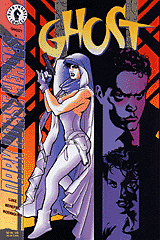 I have mixed feelings about Ghost. There's a lot about it that I really like, but there's also a fair amount about it that I'm not always sure I approve of.
There have been about thirty issues, and several teams of artists, but on the whole the art is top-notch. The writing, too, is good. What troubles me is that the book treads along the edges of much of what I don't like in the comics of the last several years. This page will explore some of what troubles me about the book as well as the things that I really like about it.
I have mixed feelings about Ghost. There's a lot about it that I really like, but there's also a fair amount about it that I'm not always sure I approve of.
There have been about thirty issues, and several teams of artists, but on the whole the art is top-notch. The writing, too, is good. What troubles me is that the book treads along the edges of much of what I don't like in the comics of the last several years. This page will explore some of what troubles me about the book as well as the things that I really like about it.
To start out on a positive foot, as I have said, the art is usually excellent. The first two artists associated with Ghost were Adam Hughes and Matt Haley. Hughes is one of the finest "good girl" artists today. I've mentioned him in my page on Cheesecake, the art of the pin-up, and the one on the Maze Agency comicbook. The cover to issue 6, shown at the top of this page is one of his. Matt Haley is an artist of much the same school, and if he is overshadowed by Hughes, few other artists could do so. After Hughes and Haley left the book, the art was uneven as a succession of artists came and went, but for the last year, the team of Ivan Reis and Randy Emberlin has done a credible job. Examples of their work can be seen below.
The quality of the writing has largely tracked that of the art. Whenever he's had a strong, stable team, author Eric Luke has done an solid job of characterization, and writing in general. My misgivings about the book are more with the world view and message that the book conveys than with the artistry with which it is done.
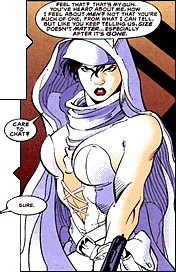
Ghost is the story of, not surprisingly, a ghost. Like the Spectre or Deadman before her, Ghost's story opens with her death, and with her seeking her killer. Unlike Jim Corrigan and Boston Brand's shades, though, Elisa Cameron's ghost starts out with no memory of her previous life. This leaves her with two mysteries to solve, her life and her death. She also ends up on something of a crusade against men who victimize women.
Visually, Ghost is something like a reverse Shadow, and in fact had a cross-over with him. Both pack a pair of .45 caliber pistols, but where he is a sharp-feathered man swathed in black, she is a beautiful woman shrouded in white. Like the Shadow, she is ruthless. The men responsible for her death and those of her loved ones, as well as a number of men who predate on women, end up dead at her hands.
Ghost's attitude is a part of the first thing that bothers me about Ghost. For instance, her dialog in the panel above taken from issue #20, reads:
Feel that? That's my gun. You've heard about me. How I feel about men? Not that you're much of one, from what I can tell. But like you keep telling us, size doesn't matter... Especially after it's gone.
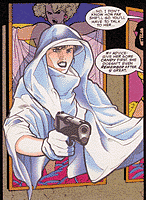 Some attitude, eh? And a bit reminiscent of all the
"Bad Girls", the dark and dangerous women with attitude that so fill the comics today. Survey the racks and you'll find comic after comic featuring women barely clad in leather, sprouting, wearing or wielding sharp and deadly instruments, and chock full of attitude. These "bad girls" are incarnations of the age-old image of the woman as predator, the demonized woman -- dangerous, emasculating and tempting. She has appeared as villainesses in myth and fiction for millennia as vampires, succubi, temptresses, monsters and she-demons. Not a positive image of women.
Some attitude, eh? And a bit reminiscent of all the
"Bad Girls", the dark and dangerous women with attitude that so fill the comics today. Survey the racks and you'll find comic after comic featuring women barely clad in leather, sprouting, wearing or wielding sharp and deadly instruments, and chock full of attitude. These "bad girls" are incarnations of the age-old image of the woman as predator, the demonized woman -- dangerous, emasculating and tempting. She has appeared as villainesses in myth and fiction for millennia as vampires, succubi, temptresses, monsters and she-demons. Not a positive image of women.
Ghost isn't one of the "bad girls", though. She's a more complicated, richly texture, and in the end, real, woman than they. Wrapped in her voluminous white shroud she is a haunting figure and, like many a real woman, an ex-victim. Several of the "bad girls" are also women who were once victimized, but their reaction seems qualitatively different. Ghost feels a definite remorse and has a conscience. She may distract her enemies with her womanly charms, but she doesn't turn into a seductress or temptress. She is angry over her victimization and that of others and seeks justice more than vengeance.
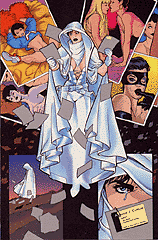 This all touches on the next aspect that bothers me. This one has to do specifically with how authentic and real Ghost is as a character. If the "Bad Girls" are the age-old image of woman as temptress, and Ghost more a reflection of real women that are victimized, the problem seems to me to be that she is too often cast as being Everywoman. She tends to assume that men are all victimizers and a very large percentage of the ones she encounters are. Further, a very large portion of the women are victims. At times it seems like she and/or the author are casting all men as victimizers and all women as victims. This bothers me both because I think it's not true and because it lets the victimizers off too easily. If all men are predators, than any individual man can escape responsibility for his actions. He's just following his nature.
This all touches on the next aspect that bothers me. This one has to do specifically with how authentic and real Ghost is as a character. If the "Bad Girls" are the age-old image of woman as temptress, and Ghost more a reflection of real women that are victimized, the problem seems to me to be that she is too often cast as being Everywoman. She tends to assume that men are all victimizers and a very large percentage of the ones she encounters are. Further, a very large portion of the women are victims. At times it seems like she and/or the author are casting all men as victimizers and all women as victims. This bothers me both because I think it's not true and because it lets the victimizers off too easily. If all men are predators, than any individual man can escape responsibility for his actions. He's just following his nature.
To the extent that this sexual dichotomy is merely in Ghost's assumptions and view of reality, I don't object to it. I've known a number of people who are similar to her in this. It is when the author seems to show the world as actually like this that I am troubled.
A related problem I occasionally have with Ghost is wondering if by stressing the victimization of women by men it doesn't come a bit close to other works that do so as an excuse to show women abused or exploited. Several of the artists on the book are excellent at glamour and pin-up art. The women they draw can hardly help but be attractive, and so when they portray women being exploited in strip clubs or by porn producers, their work can make the victimization look too pretty and border on being what they decry. The page shown to the right, where Ghost discovers her sister Margot's porno career is an example. Don't get me wrong. I enjoy and approve of cheesecake. It's just that the story line has made it clear that Margot is being taken advantage of and degraded, and Hughes seems to have put a deal too pretty a face on that.
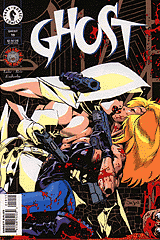
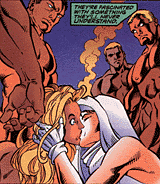 Another example is the scene featured on the cover of issue #19. In that story a demon has possessed the denizens of a small town, and Ghost and Barb Wire (she who was made into a movie starring Pamela Anderson Lee) are facing the cadets of the local military academy who are set on rape and murder. Ghost gets a sudden idea and sweeps Barb into a passionate kiss (at least on her part -- Barb is too startled to play it well). Their attackers are fascinated and confused. They stop and stare slack jawed, giving Ghost and Barb a chance to go on the offensive. They break through and attack the demon, who retreats. So, was Ghost pandering to the cadets or to us the readers?
Another example is the scene featured on the cover of issue #19. In that story a demon has possessed the denizens of a small town, and Ghost and Barb Wire (she who was made into a movie starring Pamela Anderson Lee) are facing the cadets of the local military academy who are set on rape and murder. Ghost gets a sudden idea and sweeps Barb into a passionate kiss (at least on her part -- Barb is too startled to play it well). Their attackers are fascinated and confused. They stop and stare slack jawed, giving Ghost and Barb a chance to go on the offensive. They break through and attack the demon, who retreats. So, was Ghost pandering to the cadets or to us the readers?
I think the story is honest, or mostly so, but that the cover slips toward or into pandering to the "Bad Girl" crowd. Compare the cover, to the left, with one of the actual panels from the story, to the right. The tone of the two pictures is quite different.
I suppose one of the things that particularly bothers me about the use of the kiss to create a titillating cover that confounds sex and violence is that it sullies the ground a bit for an interesting story line that showed up a couple of issues later.
Ghost has very few positive relationships with the living. Most of the people close to her -- her parents, her sister Margot, and even her living self -- have been murdered. Most of the people she deals with directly are victims or villains. Beyond that, she entered the afterlife with no memories, with no notion who she was, and since then has learned that the Hell and many of the demons and monsters she has faced are of her own creation.
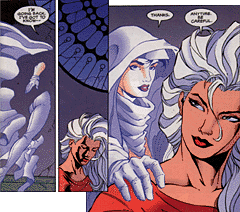
She does, however, have one love story. The only person that Ghost trusts completely is Focus, the leader of a team of superpowered women called The Furies. Their relationship isn't an explicitly sexual one, in a physical sense. After all, Ghost is not inherently a physical being. Without that physicality, the fact that they are both women isn't particularly important. The way that they reach out to each other isn't sexual but it is intimate. Both women normally shut out the world. Focus is the only person Ghost allows herself to trust, and Ghost is the first person that Focus has invited into her home in a longish time.
The growth of their intimacy and their fascination with each other, the fact that each seems at least at first to think their feelings are not returned, is very authentic and touching. It could be anyone's love story. The three panel sequence to the right comes from Ghost's first visit to Focus's home. Ghost suddenly has to leave, to investigate what they've learned. I found Focus's reaction to her departure, and to her return very evocative. It, and a few other sequences like it are the reason I label this a love story.
For me, at least, the rather tawdry cover portrayal of Ghost and Barb's kiss weakens the impact of the Ghost/
What we see here is very much the same thing that Superman was talking about in Kingdom Come, the responsibility of the superhumans, reponsibility for their own actions and as the protectors of humanity. It is this that redeems Ghost, both the character in the comic and the comic itself.
I heartily recommend Ghost. It isn't the perfect comic, but it reflects enough of the positive trends I see in comics today to overcome its occassional shortcominngs. In it we find a strong, independant female character, an affirmation of heroism and heroic ideals, artwork that is always good, and at times superb, and even, in a way, an exploration of humanity in the context of the world of comic book superheroes.
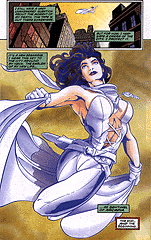 That artistry, and the fact that the over-all story is an intriguing one are what keeps me buying the comic. Taken as a whole, the story of ghost is one of self-discovery and redemption. Slowly she goes from a shade with no past, obsessed with only one thing, revenge upon her unknown killers. This is not so easy a thing. As with any event, there is not merely one person responsible for her death. Each time she takes revenge, there is still some loose-end, another plot within a plot. As her quest is drawn out she discovers much more about herself than she thought. She finds love, duty, and redemption. The picture to the right shows Ghost at the end of a four-issue story entitled "The Exhumation of Elisa". In it, she begins to act not merely for herself, for her own revenge, but to protect others, first a community of "goblins" that live beneath the city, and ultimately the whole city of Arcadia. The captions read:
That artistry, and the fact that the over-all story is an intriguing one are what keeps me buying the comic. Taken as a whole, the story of ghost is one of self-discovery and redemption. Slowly she goes from a shade with no past, obsessed with only one thing, revenge upon her unknown killers. This is not so easy a thing. As with any event, there is not merely one person responsible for her death. Each time she takes revenge, there is still some loose-end, another plot within a plot. As her quest is drawn out she discovers much more about herself than she thought. She finds love, duty, and redemption. The picture to the right shows Ghost at the end of a four-issue story entitled "The Exhumation of Elisa". In it, she begins to act not merely for herself, for her own revenge, but to protect others, first a community of "goblins" that live beneath the city, and ultimately the whole city of Arcadia. The captions read:
I still have a vast unanswered question about the moment of my death. the tape is out there somewhere.
But for now, I keep safe the dream of the city. I protect it.
It's a new beginning. I wear this key to the city around my neck. The emblem of my new life
... as sentinel of Arcadia.
The end... and the beginning.
|| Previous
| Comics Page
| JimB's Home Page
| Next
||
Copyright ©1994-2005 Jim Burrows.
Last Updated: Jul 15, 2008
All Rights Reserved.